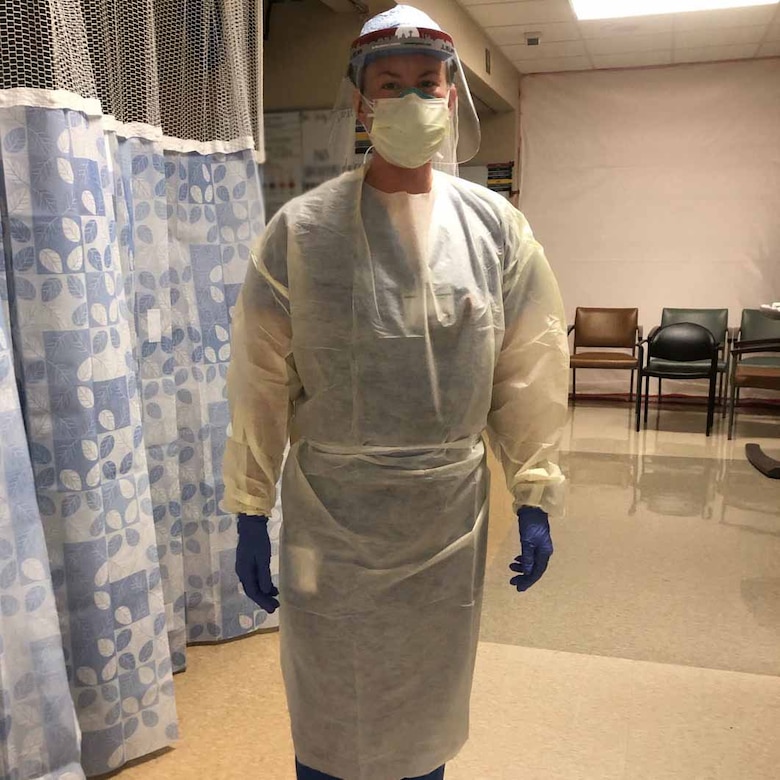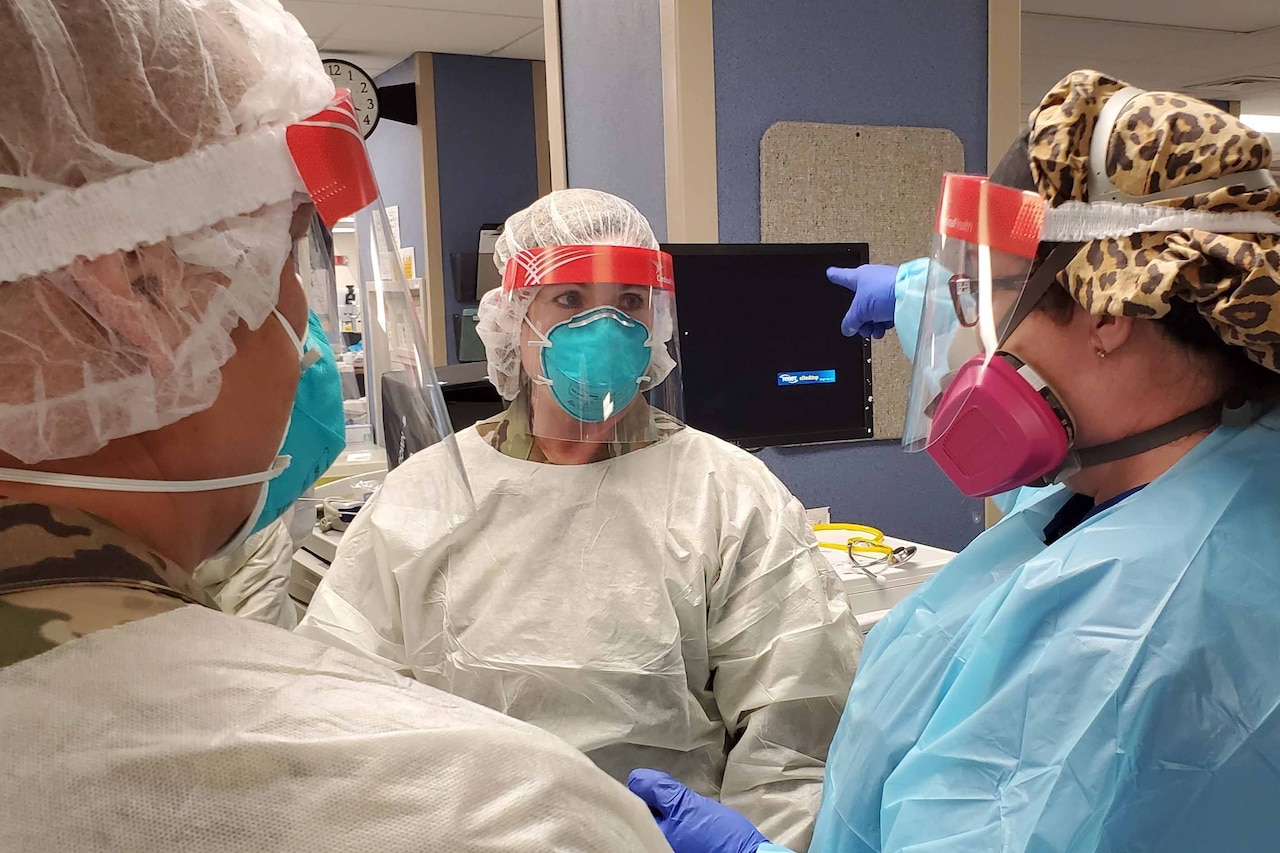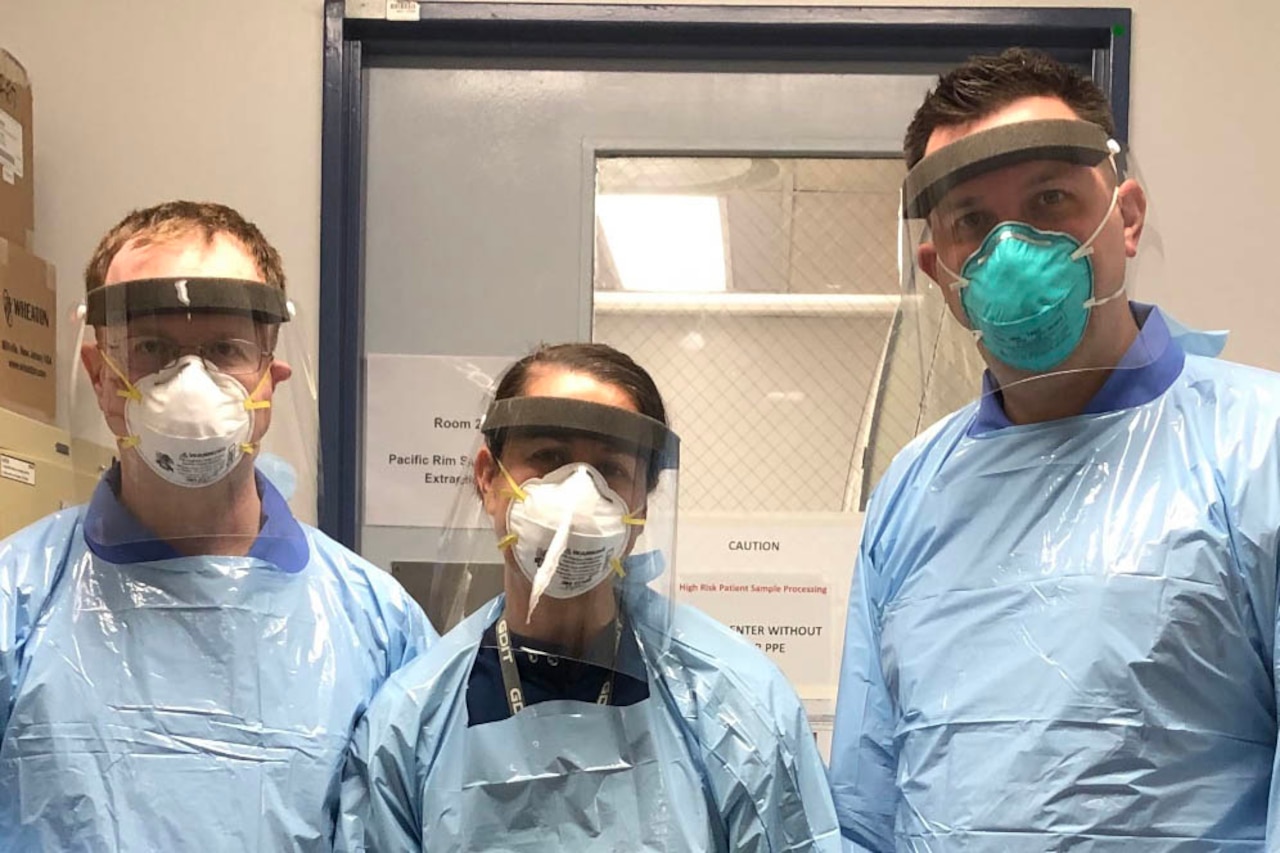Navy Petty Officer 3rd Class Cristiana Rojas, a member of the U.S. Naval Forces Europe Band’s Alliance Jazz Combo, performs at a music festival in Ravello, Italy, Aug. 30, 2020.
Providing up-to-date information, news and original content on American Military issues.
Navy Petty Officer 3rd Class Cristiana Rojas, a member of the U.S. Naval Forces Europe Band’s Alliance Jazz Combo, performs at a music festival in Ravello, Italy, Aug. 30, 2020.
Sailors conduct preflight checks on a Navy EA-18G Growler aboard the USS Ronald Reagan in the Philippine Sea, Aug. 31, 2020.
Air Force Staff Sgt. Corbin Bailey and Air Force Lt. Col. Sarah Davis, both assigned to the Vermont Air National Guard’s 158th Medical Group, screen and test members of the 134th Fighter Squadron and 158th Fighter Wing for COVID-19, South Burlington, Vt., Aug. 21, 2020. After returning from the deployment to Volk Field, Wis., members of the Vermont Air National Guard all tested negative for COVID-19.
Army Col. Deydre Teyhen, commander of Walter Reed Army Institute of Research, certifies cell starting material from liquid nitrogen storage signifying the initiation of the institution’s COVID-19 vaccine material in Silver Spring, Md., Aug. 26, 2020. The institute is supporting COVID-19 response efforts.
Sept. 3, 2020
As part of the Operation Warp Speed (OWS) goal to deliver safe and effective vaccines and therapeutics by January 2021, five DoD locations have been identified to participate in the Phase III trial evaluating the vaccine candidate AZD1222 under development by AstraZeneca.
“The Department of Defense continues to play a key role in the development of a potential COVID-19 vaccine,” said Honorable Tom McCaffery, Assistant Secretary of Defense for Health Affairs. “Now that vaccines have passed the first phases of testing for safety, dosing and response, we are ready to move into the next phase where volunteers are needed to join large clinical studies. We are excited to have several sites identified to support the next steps in the vaccine development process.”
The DoD sites selected are:
To volunteer, visit www.CoronavirusPreventionNetwork.org, click on “Volunteer Now” and complete the survey. Once the survey is completed, local study site coordinators will contact Military Health System beneficiary volunteers in their area who are a good match for the study. Please be sure to enter the appropriate site code.
To ensure that the vaccines work to protect those at greatest risk, participation by people from communities that are hardest hit is critical. The study is looking for people who are at an increased risk of SARS-CoV-2 infection which may include:
OWS is a U.S. government, interagency endeavor that is focused on delivering 300 million doses of a safe, effective vaccine for COVID-19 and is part of a broader strategy to accelerate the development, manufacturing, and distribution of vaccines, therapeutics, and diagnostics (countermeasures) for the virus.
Direct support for this effort is provided by the U.S. Department of Defense's (DoD) Joint Program Executive Office for Chemical, Biological, Radiological and Nuclear Defense (JPEO-CBRND) in coordination with the Office of the Assistant Secretary of Defense for Health Affairs (OASD(HA))and the Defense Health Agency (DHA).
Sept. 3, 2020 | BY Lori Bultman, Air Force , 502nd Air Base Wing
U.S. Army North is the U.S. Northern Command's Joint Forces Land Component Command responsible for the Defense Department's response to COVID-19.
The first UAMTF to arrive in San Antonio, designated UAMTF-627, began treating patients at five local hospitals July 9.
Army Capt. Sarah Kopaciewicz, a U.S. Army nurse from Madigan Army Medical Center at Joint Base Lewis-McChord, Washington, is one of those working hard to assist San Antonio medical personnel with their overload of coronavirus cases.
"We are working as critical care nurses, taking care of critically ill COVID-19 patients," she said. "Our nights are busy between managing patient care and communicating with their family members or loved ones."

Kopaciewicz said San Antonians have made her feel welcome in their facilities.
"The staff at Christus Santa Rosa Hospital Westover Hills has been very welcoming toward us," she said. "They have made it easy to ask questions regarding equipment, patient movement and hospital policies."
The importance of the mission is clear.
"This mission has proven that the military can work anywhere, anytime and in any environment to provide the best care for those in need," Kopaciewicz said.
Charles Reed, vice president and associate chief nursing officer at University Health System, is thankful the task force members arrived when they did.
"Seeing how patients overwhelmed healthcare systems around the world is something that you expect on the news or in the movies," he said. "It's not something that you would ever expect to happen in your own community. We were under a lot of stress during the surge, and the military staff was able to come in and provide immediate relief to our COVID-19 units."
Reed said local hospitals were in urgent need of assistance when the task force members started arriving.
"We needed a lot more staff to care for COVID-19 patients for several reasons: higher nurse-to-patient ratios, 'gatekeepers' to ensure staff was donning and doffing personal protective equipment appropriately and more beds converted to intensive care unit care," he said. "This higher level of acuity and the need for additional beds was not only stressful for the nursing staff but for the whole medical team, including physicians, respiratory therapists and technicians."
The military staff members provided support to the entire healthcare team quickly, Reed said.
"The ICU and acute care nurses were able to assimilate into our environment and become part of 'our' team," he said. "We had a 40 to 50% increase in the number of ventilated patients, with the same number of respiratory therapists and all working mandatory overtime. The military respiratory therapists provided immediate relief, allowing us to reduce the number of vents per therapist and giving us greater coverage in both the ICUs and in the acute care units, or ACUs."
The military licensed vocational nurses were also important to getting COVID-19 patients cared for, Reed said.
"The LVNs helped us by taking over the oxygen therapy, assessments and breathing treatments — the duty that we were going to have the registered nurses complete due to the shortage of respiratory therapists," he said.

To Reed and the staff members at University Health System, the task forces' assistance was essential to their ability to combat COVID-19.
"The military staff members provided us with the resources to open up additional beds and provide care to patients that we otherwise would not have had the resources to support," he said. "They also supported us mentally, by improving the morale of our staff through their support, camaraderie, presence, knowledge, skill and professionalism. We are extremely appreciative for all the military has done for our patients and our staff."
Army Lt. Col. Jason Hughes, the commander of UAMTF-627, said helping those in need is the purpose of the UAMTFs.
"We, individually and as an organization, exist to save and sustain lives anywhere in the world," he said. "This mission is special, and our soldiers brought a burst of energy to each of our five hospitals and hope to the community."
Hughes said the hospitals in San Antonio welcomed the task force members, some of whom they had worked with before.
"The leadership at each hospital did an excellent job of integrating us into their team, which was made easier because the local military health system has a strong relationship already in place," he said. "For example, University Health System understands how the military operates because of their day-to-day training partnership, so the process was seamless and some of the faces were familiar, which reduced the initial stress of onboarding."
"I cannot thank the hospitals enough; they welcomed us with open arms and took care of us like we were family," Hughes said. "I could not be more proud of how the military and civilian partners joined together to provide the care each American deserved in their time of need."
At the request of the Federal Emergency Management Agency and state officials, approximately 740 Defense Department medical and support professionals from the Army, Navy and Air Force are assigned as part of the department's ongoing COVID-19 operations in Texas and California.
Sept. 3, 2020 | BY Amber Kurka, Army
Located at Camp Zama, Japan, and Joint Base Lewis-McChord, Washington, EMBL's mission is to protect the health of the force from vector borne diseases found in ticks, mosquitos and fleas by testing arthropod samples found in austere environments.
"Our EMBLs are always on the cutting edge of identifying new diseases emerging in our area of responsibility," explained Army Capt. Bradley Kearney, a biochemist and the PHC-P Laboratory Sciences director.
In January, Kearney and his team began tracking the news of an emerging new virus, SARS-CoV-2, with the help of Dr. Michael Butel, PHC-P's chief of epidemiology. As the new disease COVID-19 evolved, the team began to strategize how they could help clinical labs in Japan and Washington in the event of a pandemic.

"We were having meetings frequently in preparation for what we anticipated would be a pandemic before it was hardly even called an epidemic," Kearney said.
As the weeks continued, PHC-P leadership and the EMBL teams worked to identify critical laboratory assets and skill sets to help with clinical testing.
"Laboratory assets can take a very long time to spin up," Kearney explained. "To get someone qualified to do laboratory testing, the minimum threshold requires more than 50 weeks of advanced individual training, then an individual will need to do months of training in a clinical hospital. In order to have a rapid response, we tapped into those who already had the training in place. Since our team conducts vector laboratory testing regularly we had 100% of our staff from both Japan and JBLM go to support clinical efforts due to the limited availability of laboratory testers."
To help fight COVID-19, Gary Crispell, a microbiologist, and Kearney launched COVID-19 testing in Japan while Milagros Solá, a microbiologist, and Army Spc. Darius Torres, a medical laboratory technician, supplemented the clinical lab staff at MAMC.
"You have to be highly qualified and trained on the right equipment to do COVID-19 testing," Solá said. "We have to make sure that we are following all of the proper protocols to not only keep ourselves safe but to also make sure the samples are processed accurately. The results could be life or death for someone. Additionally, it takes a really special person to work under the stress and pressure of processing COVID-19 samples, because the results were needed by the medical staff yesterday."
One of the most time-consuming portions of COVID-19 testing involved lysing, the process of breaking down a cell in order to release the genetic material for each sample.
"Every sample needs to be lysed [break open the cells to get to the DNA], and it could be a long process, since you have to pipette the sample multiple times before it can go onto an instrument to process it," Torres explained. "If you don't have enough people in the lab, you end up wasting a lot of time going back and forth between lysing the samples and running the equipment."
By supplementing the lab staff at MAMC, Torres and Solá were able to take some of the stress off their clinical counterparts. Kearney and Crispell, on the other hand, worked around the clock to set up testing efforts for DOD personnel and family members stationed in Japan.
"Rather than send samples back to San Diego to be processed, which would take precious time, we partnered with the Navy to stand up a testing location at the NHRC satellite lab," Kearney said. "We moved our specialized instrument from Camp Zama to Yokosuka and were able to run the first tests for DOD members within a week."
The new ability to test in Japan helped keep the DOD and naval missions going by quickly identifying pockets of COVID-19 and reducing spread within the community.
"For me, it was very gratifying to run these clinical tests in order to clear personnel to go out on missions," Crispell said. "But the most gratifying thing was when we found pockets of COVID-19 in our community and worked with preventive medicine teams. They were able to respond quickly and conduct contact tracing to extinguish clusters of COVID-19."
To reduce outbreaks, both locations partnered with preventive medicine teams to identify and test individuals who may have come in contact with the coronavirus.

"It truly is a team effort between laboratories and preventive medicine," said Kearney. "Together, we do a lot of work behind the scenes to reduce the spread of diseases. Often we [stop] outbreaks before they happen."
Kearney pointed out that while the overall footprint of microbiology and preventive medicine are relatively small within the medical community, the mission is extremely important, and they are ready to respond.
"Historically, disease and non-battle injuries have been the number one threat to military readiness," Kearney said. "To help reduce this threat, we are behind the scenes at all times ready to protect the DOD community as a whole."
The ability to adapt and respond to the demands of COVID-19 has meant a lot to the PHC-P EMBL staff.
For Solá, helping the MAMC clinical lab was extremely personal.
"Madigan was my first duty station," Solá said. "I started out as an enlisted medical lab technician in 1993 and became the NCOIC. Three of the staff members that I used to work with are still there at the lab. I cannot explain how it makes me feel to be able to help my former teammates more than 25 years later as a civilian employee. This mission is so incredibly important, I am very proud to help."
While Solá has four years until retirement, Torres reflected on how this experience has impacted him as a young enlisted lab tech.
"A pandemic like this is not something that anyone ever expects," Torres said. "However, this experience has shown me that as a soldier, I'm not only able to battle what I was taught to fight, but together as a team, we can battle such things as a pandemic."
For Kearney, this experience is why he joined the Army.
"The involvement with COVID-19 testing really gets at the reason why I joined the Army," Kearney said. "I joined to provide my expertise and to provide my services as a biochemist to help support the warfighter and their families."
As members of PHC-P, Crispell, Kearney, Solá and Torres's dedication to care for the health and well-being of others embraced the PHC-P credo of "100/0!" which means 100% accountability and zero excuses for not giving your best every day.
"Almost anything is achievable when all of the parties are invested," Crispell said. "To me nothing is more important than the service members and civilians that we service."
"For years, the Army's number one priority has been readiness," Kearney said. "The combined team of our soldier, scientist and civilian workforce has directly and measurably made a positive impact on readiness during this pandemic. The Army laboratory enterprise stands with the rest of our healthcare force to continue the fight against COVID-19 and to support our warfighters with any medical challenge the future may hold."
(Amber Kurka is assigned to the Public Health Command - Pacific)
In its continued efforts to provide resources to service members and their families, the Department of Defense issued an info sheet highlighting a few of the many resources available to help those who may be coping with an experience of sexual assault.
As service members continue to experience daily challenges due to the COVID-19 pandemic, the DOD wants everyone to know that assistance for sexual assault remains available for all service members and their dependents.